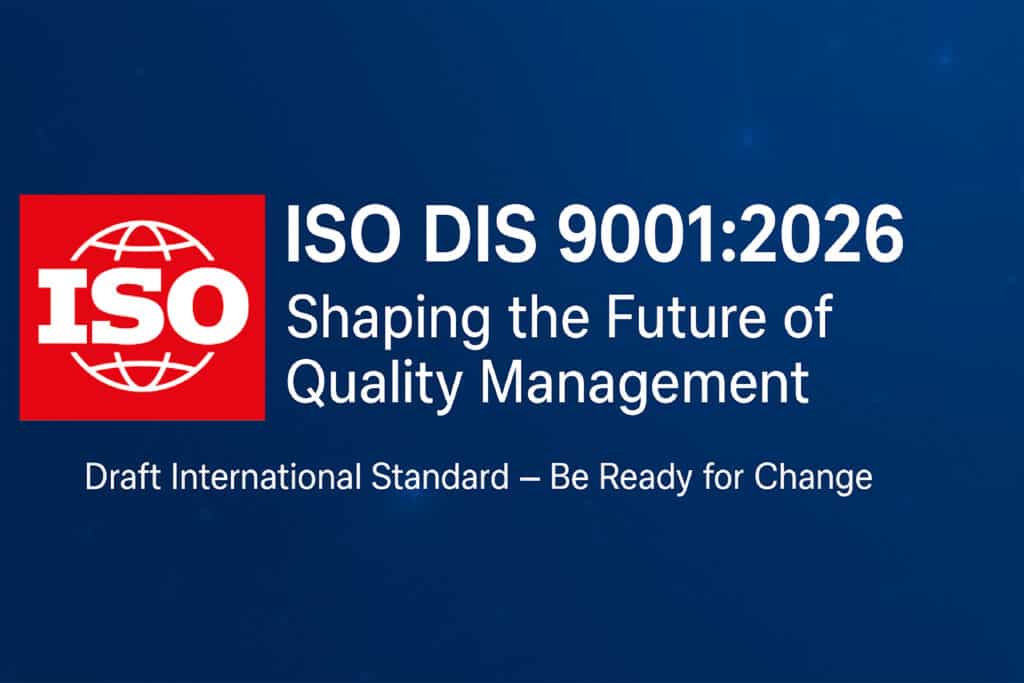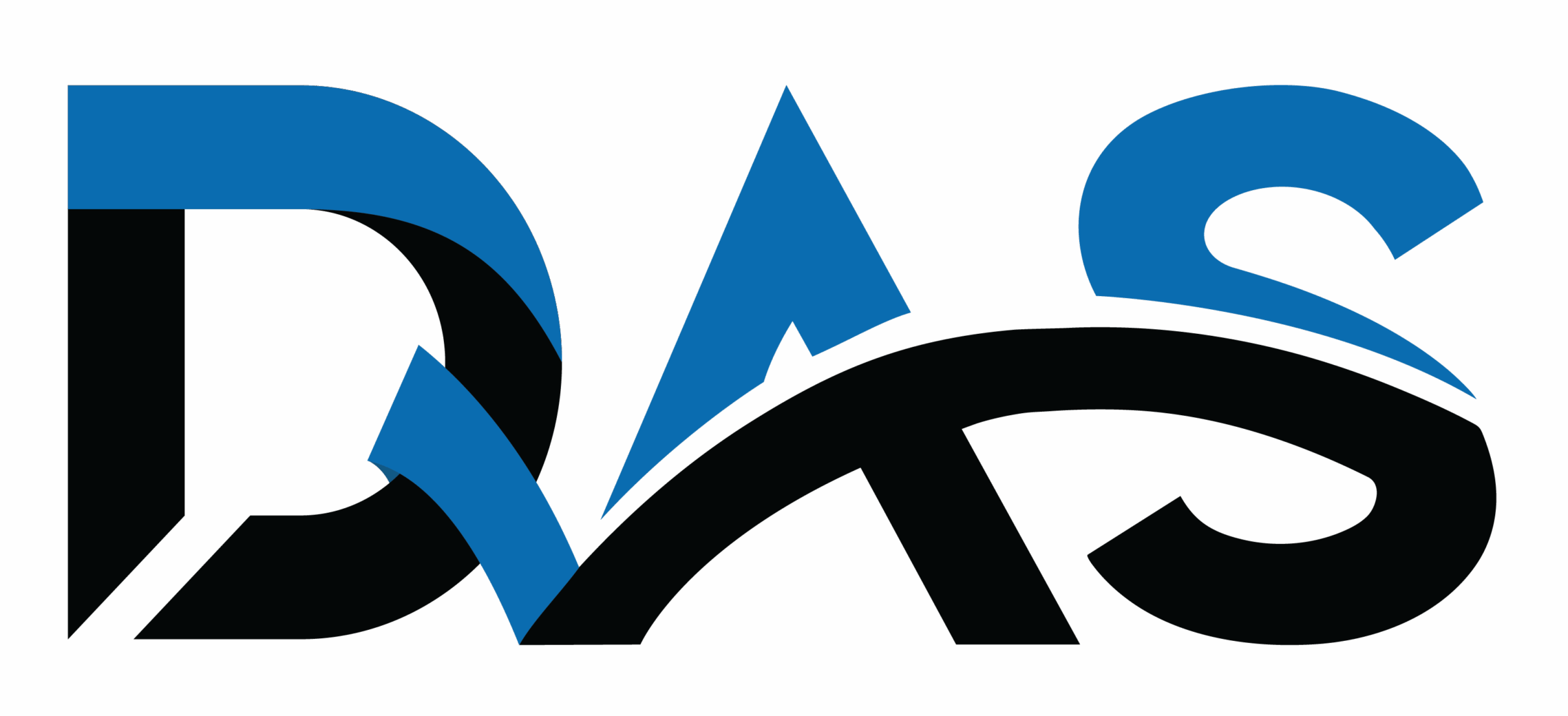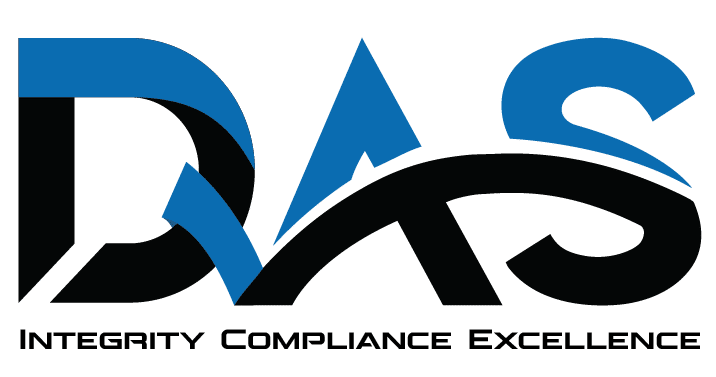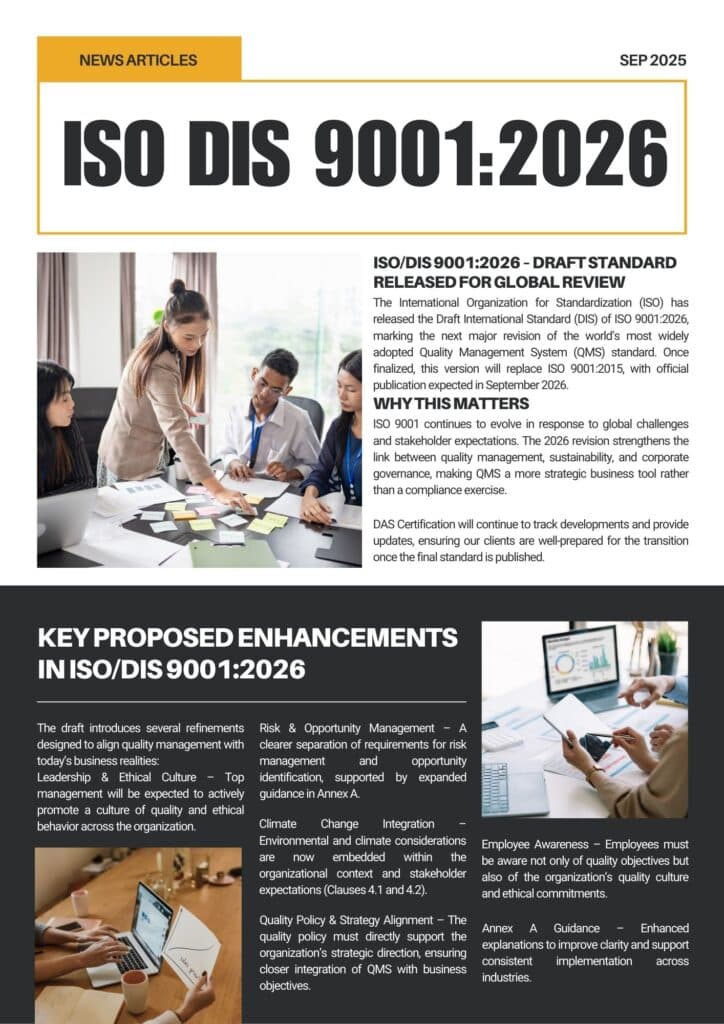
ISO/DIS 9001 is the Draft International Standard for the next version of the quality management standard, intended to replace ISO 9001:2015. It is currently in the enquiry (ballot) phase, where ISO members are reviewing it worldwide. The final version is expected to be published in September 2026.
Key New or Refined Requirements in the 2026 Revision
Leadership & Ethical Culture
Clause 5.1 now explicitly mandates that top management promote a quality culture and demonstrate ethical behavior, with practical guidance on how to do so, with this change management will have more direct involvement, this is very helpful change.
Risk vs. Opportunity Management
Clause 6.1 is reorganized with new sub clauses (6.1.1–6.1.3) to clearly separate risk and opportunity actions. Additional guidance is included in Annex A to have more clear understanding while developing QMS.
Climate Change Integration
Amendments regarding climate change—introduced in the 2024 ISO 9001 update—are now formally integrated into Clauses 4.1 and 4.2, reinforcing environmental context considerations. Environmental and Climate change is one of the serious issue for all countries around the globe, this change will lead to further strengthening the QMS requirements.
Policy Alignment with Strategy
The quality policy must now explicitly reflect the organization’s context and strategic direction, strengthening alignment between QMS and business objectives.
Employee Awareness
Clause 7.3 is expanded to require awareness of quality culture and ethical behavior among employees of the company going for QMS.
Guidance via Annex A
Now Annex A offers more detailed interpretive guidance aligned with Clauses 4–10, easing implementation and to have more clear understanding of requirements of the standard.
Consistent Structure and Terminology
The standard retains the Annex SL (now often referred to as the Harmonized Structure), ensuring consistency in structure, terminology, and alignment with other ISO management standards.
Some industry analyses anticipate further shifts and inclusions, though these may not all be formal requirements in the DIS:
| Clause | ISO/DIS 9001:2026 |
| 0.0 Introduction | Rewrite of the section on the “process approach,” with a new graphic that illustrates a typical process’s inputs and outputs, but which stops short of being a full Turtle Diagram. Despite 25 years of attempts, ISO still fails in defining the process approach in a way that will be easily understood by all, and is still treating this like rocket science. The new graphic is useful, but the surrounding text is worse than what we had in 2000.Stunningly, the entire section on risk-based thinking is removed. I am as shocked as you are. Instead, Risk Base Thinking (RBT) is now solely discussed in the guidance materials appearing in the Annex. Thankfully, the user’s “Bill of Rights” remains untouched. This is the paragraph that starts with “it is not the intent of this document…” and it is an invaluable tool for users who are harassed by uninformed auditors. |
| 1.0 Scope | Very minor rewording, no significant changes |
| 2.0 Normative references | References ISO/CD 9000 (still being drafted). |
| 3.0 Terms and Definitions | References ISO/CD 9000 (again) and points to the ISO/IEC “Electropedia” website for more definitions. Yes, “Electropedia” sounds like something Jeffrey Epstein got arrested for. Now adds definitions for: organization, interested party (stakeholder), top management, management system, quality management system, policy, quality policy, objective, quality objective, risk, process, competence, documented information, performance, continual improvement, nonconformity, corrective action, audit, measurement, monitoring. The definition of risk still claims it can be either “positive or negative.” Then a new note says, “the word ‘risk’ is sometimes used when there is the possibility of only negative consequences.” So they can’t even be consistent. There are five notes on this definition, showing TC 176 really struggling with this whole “positive risk” insanity. Still no definitions for “strategic direction” or “opportunity,” despite the terms being crucial for understanding the standard. The definitions of “monitoring” and “measurement” don’t accurately reflect the words as they are used within the context of the standard itself, and this remains a problem. In this draft, “monitoring and measuring” refers to inspection and testing until clause 8.6; at 8.6, the term “planned arrangements” is swapped in to replace “monitoring and measuring,” and by clause 9, “monitoring and measuring” takes on an entirely different meaning. It’s a mess. |
| 4.0 Context of the Organization | Included the 2024 amendment language about climate change, but no other additions. |
| 4.1 Understanding the Organization and Its Context | Included the 2024 amendment language about climate change, but no other additions. |
| 4.2 Understanding the needs and expectations of interested parties | climate change language from the ISO 9001:2015 Amendment 2024. A few minor language change, no new requirements. |
| 4.3 Determining the Scope of the Quality Management System | A few minor language Changes, no new requirements proposed. Still does not conclude that the scope statement is the expression of the organization’s “context“; |
| 4.4 Quality Management System | A few minor language change, no new requirements. Despite the change to the clause name, this is the “process approach” clause. |
| 5.0 Leadership | |
| 5.1 Leadership & Commitment | |
| 5.1.1 General | Proposed requirements for top management to promote “quality culture and ethical behavior.” More unenforceable remarks, keeping the clause largely useless and still not well audit-able. Included note that tries to explain this, but it’s weak. |
| 5.1.2 Customer Focus | No changes. 176 TC shall have given more clear line of action what need to focus on the requirements. |
| 5.2 Policy | New requirement that the Quality Policy “takes into account the context of the organization and supports its strategic direction.” Likely language mandated by the Annex SL update. The standard still never defines what a “strategic direction” is or actually requires a company to have one. |
| 5.3 Organizational Roles, Responsibilities and Authorities | New requirement to assign someone the responsibility to report “on opportunities for improvement to top management.” |
| 6.0 Planning | |
| 6.1 Actions to address risks and opportunities6.1.1 Determining Risks and Opportunities: largely the same language as 2015.6.1.2 Actions to Address Risks: largely the same language as 2015.6.1.3 Actions to Address Opportunities: new language that (cringingly) takes the exact same text from | The sub-clauses are divided as follows:6.1.2 and swaps in the word “opportunity” for “risk.” Again, TC 176 is pretending to do stuff by copying-and-pasting. They made clause 6.1 larger but without adding any new words. |
| 6.2 Quality Objectives and Planning to Achieve Them | ISO was humiliated by Oxebridge and others for toying with the idea of adding language that says objectives are to be measurable only “if practicable.” That humiliation worked, and ISO backtracked. Now, objectives (once again) must be measurable. |
| 6.2.1 only re-orders the bulleted list; no new requirements as compared to 2015. | TC 176 still does not close the loop on the process approach as the core of a QMS, and thinks process metrics and quality objectives are different things. They are not, but sure, let’s be unnecessarily redundant.6.2.2 maintains the cringeworthy “who, what, where,…” language of Annex SL and ISO 9001:2015. |
| 6.3 Planning of changes | Minor rewording and re-ordering of the prior requirements here, but without a mandate that anything be documented or recorded, the clause is largely useless. |
| 7.0 Support | |
| 7.1 Resources | |
| 7.1.1 General | No changes. |
| 7.1.2 People | No changes. |
| 7.1.3 Infrastructure | No changes. Continues to put the requirements into the note, keeping the error from ISO 9001:2015. Hey, ISO editors: you cannot have requirements in notes. I put that in boldface red font so you can read it more easily. |
| 7.1.4 Environment for the Operation of Processes | Have language on “social and psychological” factors such as “emotionally protective” workplace. The language from prior CD versions, including references to consider “technological” and “cultural” aspects, was removed. A final sentence is included in the requirements section that says, “Some factors are dependent on the organizational quality culture, including ethical behaviour.” |
| 7.1.5 Monitoring and Measuring Resources | No changes. All revisions from CD2 were removed. The standard still requires a record of all monitoring and measuring resources, but then fails to provide a record for calibrated devices. So there’s still no requirement for records of calibration. |
| 7.1.6 Organizational knowledge | No changes. |
| 7.2 Competence | No changes. |
| 7.3 Awareness | Adds requirement to ensure employees are aware of “quality culture and ethical behaviour.” |
| 7.4 Communication | No changes. Still unauditable, still doesn’t include customer communication (which instead appears in 8.2, out of place). |
| 7.5 Documented information | No Specific Change- Continues to mix up “documents” and “records,” keeping the section confusing and rambling. A lot of people complained about this in the 2015 version, but TC 176 ignored them. |
| 8.0 Operation | |
| 8.1 Operational planning and control | Maintains ISO 9001:2015’s errors of (a) not clearly explaining that the standard views “operational” and “organizational” processes differently, (b) not fixing the clause so that it can in any way be understood without a consultant. |
| 8.2 Requirements for Products and Services | |
| 8.2.1 Customer communication | No changes, but clarifies what ISO 9001:2015 meant by “contingency actions,” adding language that says these include “disruptions in the products or services provided.” Not great, but better than 2015. |
| 8.2.2 Determining the Requirements Related to Products and Services | No changes. |
| 8.2.3 Review of Requirements Related to Products and Services | No changes. |
| 8.2.4 Changes to Requirements for Products and Services | No changes. |
| 8.3 Design and Development of Products and Services | No changes. |
| 8.4 Control of Externally Provided Processes, Products and Services | No changes. |
| 8.5 Production and Service Provision | No changes. |
| 8.5 Production and Service Provision | No changes. |
| 8.5 Production and Service Provision | No changes. |
| 8.5.1 Control of Production and Service Provision | No changes. |
| 8.5.2 Identification and Traceability | No changes. |
| 8.5.3 Property Belonging to Customers or External Providers | No changes. Still puts the requirements in the notes, so: |
| 8.5.4 Preservation | No changes. Still puts the requirements in the notes, so: |
| 8.5.5 Post-delivery activities | No changes. This clause still doesn’t know what it wants to say. Still puts the requirements in the notes, so: |
| 8.5.6 Control of changes | No changes. |
| 8.6 Release of Products and Services | No changes. Still maintains the horrid 2015 error or switching terms mid-standard. The clause is not about “release” (delivery) at all. |
| 8.7 Control of Nonconforming Outputs | No changes, and we desperately needed fixes here. |
| 9.0 Performance evaluation | |
| 9.1 Monitoring, Measurement, Analysis and Evaluation | |
| 9.1.1 General | No changes, remains nearly entirely useless. |
| 9.1.2 Customer satisfaction | No changes. |
| 9.1.3 Analysis and Evaluation | No changes. |
| 9.2 Internal Audit Programme | The 2015 version required you to perform audits to ensure conformity with ISO 9001 and against your own QMS requirements. |
| 9.3 Management Review | No changes. |
| 10.0 Improvement | |
| 10.1 General | No changes to requirements. |
| 10.3 Continual improvement | No changes. |
New Annex A
This version expands the Guidance material first cooked up in CD2’s first draft. This is where TC 176 spent all of its time, while ignoring the key clause 8 material that really needed to be fixed. This is what happens when you allow consultants, rather than end users, to write standards. They consult.
In the Annex A guidance, there’s a single brief mention of “emerging technologies” as it relates to document control, and then a brief discussion on “digitalization” under the guidance on continual improvement.


